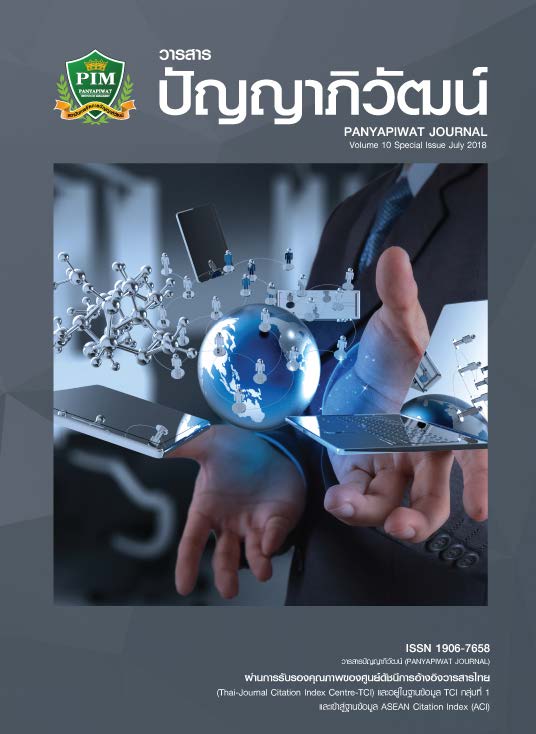การศึกษาความสัมพันธ์เชิงพยากรณ์ระหว่างคุณลักษณะความเป็นผู้ประกอบการทางสังคมขององค์กรกับความยั่งยืนทางเศรษฐกิจขององค์กรธุรกิจในประเทศไทย
Main Article Content
บทคัดย่อ
การวิจัยครั้งนี้ทดสอบความสัมพันธ์เชิงพยากรณ์ระหว่างคุณลักษณะความเป็นผู้ประกอบการทางสังคมขององค์กรกับความยั่งยืนทางเศรษฐกิจของบริษัทในตลาดหลักทรัพย์แห่งประเทศไทย ข้อมูลที่ใช้ในการวิเคราะห์เป็นค่าเฉลี่ยข้อมูล 3 ปีใน พ.ศ. 2555-2557 ของบริษัทจดทะเบียนในตลาดหลักทรัพย์จำนวน 402 องค์กร ประกอบด้วย 8 หมวดอุตสาหกรรม ทำการวิเคราะห์โดยใช้สถิติเชิงพรรณนาและการวิเคราะห์ถดถอยวิธี Partial Least Squares ผู้วิจัยได้พัฒนาตัวแปรใหม่เชิงปริมาณเพื่อใช้วัดปัจจัยคุณลักษณะความเป็นผู้ประกอบการทางสังคมขององค์กร ผลการวิจัยพบว่า (1) ตลาดทุนมีความสามารถในการทำกำไรที่ดี โดยพิจารณาจากอัตราส่วนกำไรต่อส่วนของผู้ถือหุ้นและอัตราส่วนกำไรต่อสินทรัพย์ทั้งหมดมีค่าเป็นบวก (2) บริษัทในตลาดหลักทรัพย์มีการดำเนินงานด้านสังคมหรือสิ่งแวดล้อมไม่สูงนัก (3) ตัวแปรแฝงของงานวิจัยมีความตรงเชิงสอดคล้อง (AVE > 0.5) ส่วนการตรวจสอบโมเดลการวัดด้วยการวิเคราะห์ความน่าเชื่อถือพบว่า อยู่ในระดับยอมรับได้ (Cronbach’s alpha > 0.7) (4) คุณลักษณะความเป็นผู้ประกอบการทางสังคมขององค์กรมีอิทธิพลเชิงบวกต่อความยั่งยืนทางเศรษฐกิจขององค์กรอย่างมีนัยสำคัญ (สัมประสิทธิ์เส้นทาง = 0.324) และคุณลักษณะความเป็นผู้ประกอบการทางสังคมขององค์กรสามารถอธิบายความแปรปรวนของความยั่งยืนทางเศรษฐกิจขององค์กรได้ร้อยละ 10.5 และ (5) ตัวแปรที่สำคัญของคุณลักษณะความเป็นผู้ประกอบการทางสังคมขององค์กรมี 8 ตัวแปร ได้แก่ จำนวนความร่วมมือ/โครงการกับองค์กรอื่น การระบุการมุ่งสังคม/ความยั่งยืนในสารจากประธานกรรมการ การส่งเสริมให้พนักงานเข้าร่วมกิจกรรมทางสังคมหรือสิ่งแวดล้อม การจัดทำรายงานทางด้านสังคม/สิ่งแวดล้อม/ความยั่งยืน จำนวนช่องทางในการให้ข้อมูลกับผู้มีส่วนได้ส่วนเสีย การมีพันธกิจเพื่อสังคมในแผนกลยุทธ์หรือเป้าหมายทางธุรกิจ จำนวนกิจกรรมเกี่ยวกับสังคมหรือสิ่งแวดล้อม และอันดับบรรษัทภิบาล
Article Details
“ข้าพเจ้าและผู้เขียนร่วม (ถ้ามี) ขอรับรองว่า บทความที่เสนอมานี้ยังไม่เคยได้รับการตีพิมพ์และไม่ได้อยู่ระหว่างกระบวนการพิจารณาลงตีพิมพ์ในวารสารหรือแหล่งเผยแพร่อื่นใด ข้าพเจ้าและผู้เขียนร่วมยอมรับหลักเกณฑ์การพิจารณาต้นฉบับ ทั้งยินยอมให้กองบรรณาธิการมีสิทธิ์พิจารณาและตรวจแก้ต้นฉบับได้ตามที่เห็นสมควร พร้อมนี้ขอมอบลิขสิทธิ์บทความที่ได้รับการตีพิมพ์ให้แก่สถาบันการจัดการปัญญาภิวัฒน์หากมีการฟ้องร้องเรื่องการละเมิดลิขสิทธิ์เกี่ยวกับภาพ กราฟ ข้อความส่วนใดส่วนหนึ่งและ/หรือข้อคิดเห็นที่ปรากฏในบทความข้าพเจ้าและผู้เขียนร่วมยินยอมรับผิดชอบแต่เพียงฝ่ายเดียว”
เอกสารอ้างอิง
Aggarwal, P. (2013). Sustainability reporting and its impact on corporate financial performance: A literature review. Indian Journal of Commerce & Management Studies, 4(3), 51-59.
Crisan, C. M. & Borza, A. (2012). Social entrepreneurship and corporate social responsibilities. International Business Research, 5(2), 106-113.
Dave, P., Wadhwa, V., Aggarwai, S. & Seetharaman, A. (2013). The impact of research and development on the financial sustainability of information technology (IT) companies listed on the S&P500 index. Journal of Sustainability Development, 6(11), 123-138.
Ergin, E. (2012). Corporate governance ratings and market-based financial performance: Evidence from Turkey. International Journal of Economics and Finance, 4(9), 61-68.
Esposito Vinzi, V. (2007). The PLS Approach to Data Exploration and Modeling: An everlasting matter of dispute or a playground for integrating different cultures? In PLS and Related Methods: Proceedings of the PLS’07 International Symposium (H. Martens, T. Naes and M. Martens, Eds.). Matforsk, As, Norway, 8–11.
Gandy, J. D. (2012). The relationship between social entrepreneurship and organizational effectiveness (Doctoral dissertation). Texas, US: Dallas Baptist University.
Garson, G. D. (2016). Partial Least Squares: Regression & Structural Equation Models. US: Statistical Associates Publishing.
Haat, M. H. C., Rahman, R. A. & Mahenthiran, S. (2008). Corporate governance, transparency and performance of Malaysian companies. Managerial Auditing Journal, 23(8), 744-778.
Hadad, S. & Gauca, O. (2014). Social impact measurement in social entrepreneurship organizations. Management & Marketing: Challenges for the Knowledge Society, 9(2), 119-136.
Hair, J. F., Black, W. C., Babin, B. J. & Anderson, R. E. (2014). Multivariate data analysis (7th ed.). US: Pearson Education.
Hair, J. F., Hult, G. T. M., Ringle, C. M. & Sarstedt, M. (2017). A Primer on Partial Least Squares Structural Equation Modeling (PLS-SEM) (2nd ed.). California: SAGE Publications.
Henseler, J., Hubona, G. & Ray, P. A. (2016). Using PLS path modeling in new technology research: Updated guidelines. Industrial Management & Data Systems, 116(1), 2-20.
Hervieux, C., Gedajlovic, E. & Turcotte, M. B. (2010). The legitimization of social entrepreneurship. Journal of Enterprise Communities: People, and Places in the Global Economy, 4(1), 37-67.
Jackson, C. A. (2014). Corporate social responsibility training: Exploring the antecedents to corporate social entrepreneurship (Doctoral dissertation). Kansas, US: Kansas State University.
Jiao, H. (2011). A conceptual model for social entrepreneurship directed toward social impact on society. Social Enterprise Journal, 7(2), 130-149.
Joseph, C. (2013). Understanding sustainable development concept in Malaysia. Social Responsibility Journal, 9(3), 441-453.
Lipunga, A. M. (2014). Corporate governance practices in commercial banking sector of Malawi: Evidence from annual reports. Journal of Applied Finance & Banking, 4(5), 115-133.
Mathew, S. K. & Rajan, T. (2013). Sustainability as an imperative and an opportunity: The case of Infosys Limited. Emerald Emerging Markets Case Studies, 3(2), 1-16.
McPhee, W. (2014). A new sustainability model: Engaging the entire firm. Journal of Business Strategy, 35(2), 4-12.
Michelon, G. (2011). Sustainability disclosure and reputation: A comparative study. Corporate Reputation Review, 14(2), 79-96.
Miles, J. A. (2012). Management and Organization Theory: A Jossey-Bass reader. San Francisco: John Wiley & Sons.
Mitchell, S. F. (2012). An empirical investigation: How small to mid-sized enterprises use innovation on the path toward ecological sustainability(Doctoral dissertation). New Hampshire, US: University ofNew Hampshire.
Movassaghi, H. & Bramhandkar, A. (2012). Sustainability strategies of leading global firms and their financial performance: A comparative case based analysis. Journal of Applied Business and Economics,13(5), 21-34.
Pandey, C. L. (2014). The limits of climate change agreements: From past to present. International Journal of Climate Change Strategies and Management, 6(4), 376-390.
Rahman, M. A. & Mazlan, A. R. (2014). Determinants of financial sustainability of microfinance institutions in Bangladesh. International Journal of Economics and Finance, 6(9), 107-116.
Savitz, A. W. (2013). Talent, transformation, and the triple bottom line: How companies can leverage human resources to achieve sustainable growth. San Francisco: Jossey-Bass.
Siew, R. Y. J., Balatbat, M. C. A. & Carmichael, D. G. (2013). The relationship between sustainability practices and financial performance of construction companies. Smart and Sustainable Built Environment, 2(1), 6-27.
Siminica, M., Craciun, L. & Dinu, A. (2015). The impact of corporate sustainability strategies on the financial performance of Romanian companies in the context of green marketing. Amfiteatru Economic, 17(40), 994-1010.
Stanley, S. (2012). The Evolution of Sustainability: A Public Relations and Business Argument(Master’s Thesis). California, US: University of Southern California.
Saul, P. (2011). Social innovation Inc.: 5 strategies for driving business growth through social change. USA: HB Printing.
Szekely, F. & Strebel, H. (2013). Incremental, radical and game-changing: Strategic innovation for sustainability. Corporate Governance, 13(5), 467-481.
Thompson, B. A. (2011). Evaluation of Factors on Financial Performance of the North American Cable Industry. Doctoral dissertation, Northcentral University.
Ufere, K. J., Uche, A. G. & Alias, B. B. (2016). Social determinants of voluntary carbon information disclosure in the real estate sector of Malaysia. Studia Ubb Negotia, LXI, 3, 69-83.
Vintila, G. & Gherghina, S. C. (2012). An empirical examination of the relationship between corporate governance ratings and listed companies’ performance. International Journal of Business and Management, 7(22), 46-61.


